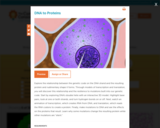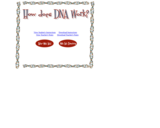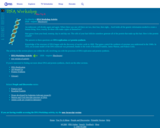
See this close-up animation showing how ribosomes carry out translation to make a particular proteins. [3:04]
- Subject:
- Science
- Material Type:
- Audio/Video
- Provider:
- Howard Hughes Medical Institute
- Provider Set:
- BioInteractive
- Date Added:
- 10/01/2022

See this close-up animation showing how ribosomes carry out translation to make a particular proteins. [3:04]

Once the structure of DNA was discovered, the next challenge was determining how the sequence of letters coded for the 20 amino acids could make protein. In theory, one or two letters can only code for 4 or 16 amino acids, respectively. A scheme using three letters, a triplet code, is the minimum necessary to encode for all the amino acids. [1:08]

Watch this microscopic animation of genetic translation in action. [2:06]

Biology 2e is designed to cover the scope and sequence requirements of a typical two-semester biology course for science majors. The text provides comprehensive coverage of foundational research and core biology concepts through an evolutionary lens. Biology includes rich features that engage students in scientific inquiry, highlight careers in the biological sciences, and offer everyday applications. The book also includes various types of practice and homework questions that help students understand—and apply—key concepts. The 2nd edition has been revised to incorporate clearer, more current, and more dynamic explanations, while maintaining the same organization as the first edition. Art and illustrations have been substantially improved, and the textbook features additional assessments and related resources.


By the end of this section, you will be able to do the following:
Describe the different steps in protein synthesis
Discuss the role of ribosomes in protein synthesis

In this interactive activity adapted from the University of Nebraska, learn how and where transcription and translation occur within a cell and observe both processes in detail.

Students investigate the relationship between proteins and amino acids digested in the small intestine while examining overall cell structure and function.

See how DNA is copied through a process called replication. Learn how information in DNA can be used to make a protein. [15:24]
Khan Academy learning modules include a Community space where users can ask questions and seek help from community members. Educators should consult with their Technology administrators to determine the use of Khan Academy learning modules in their classroom. Please review materials from external sites before sharing with students.

See how DNA is copied by replication, and learn how information in DNA can be used to make a protein. [15:23]
Khan Academy learning modules include a Community space where users can ask questions and seek help from community members. Educators should consult with their Technology administrators to determine the use of Khan Academy learning modules in their classroom. Please review materials from external sites before sharing with students.

As a class, students work through an example showing how DNA provides the "recipe" for making our body proteins. They see how the pattern of nucleotide bases (adenine, thymine, guanine, cytosine) forms the double helix ladder shape of DNA, and serves as the code for the steps required to make genes. They also learn some ways that engineers and scientists are applying their understanding of DNA in our world.

Explore the relationship between the genetic code on the DNA strand and the resulting protein and rudimentary shape it forms. Through models of transcription and translation, you will discover this relationship and the resilience to mutations built into our genetic code. Start by exploring DNA's double helix with an interactive 3D model. Highlight base pairs, look at one or both strands, and turn hydrogen bonds on or off. Next, watch an animation of transcription, which creates RNA from DNA, and translation, which 'reads' the RNA codons to create a protein.

In this visualization adapted from the University of Massachusetts Medical School, discover the role that dengue viral proteins play in a human cell as the virus prepares to replicate.

Learning about transcription and translation can be difficult but this animation helps make the processes less confusing. The animation is interactive and it also covers the overall importance of proteins.

Ever wonder how a firefly creates light? Trace the process of light production in a firefly from transcription to the production of light as you watch this informative animation.

Students learn how engineers apply their understanding of DNA to manipulate specific genes to produce desired traits, and how engineers have used this practice to address current problems facing humanity. They learn what genetic engineering means and examples of its applications, as well as moral and ethical problems related to its implementation. Students fill out a flow chart to list the methods to modify genes to create GMOs and example applications of bacteria, plant and animal GMOs.

Could a Tyrannosaurus be created in a modern-day lab? Join paleontologist, Jack Horner, in using protein sequencing to find the closest relative to the T-Rex, and then hypothetically re-creating a specimen in the lab.

Learn about the molecular structure of RNA. [11:30]
Khan Academy learning modules include a Community space where users can ask questions and seek help from community members. Educators should consult with their Technology administrators to determine the use of Khan Academy learning modules in their classroom. Please review materials from external sites before sharing with students.

How does DNA perform those all-important functions of replication and protein synthesis? This interactive feature, from the Web site developed for the PBS series "A Science Odyssey," will help you explore and understand the secrets of DNA.